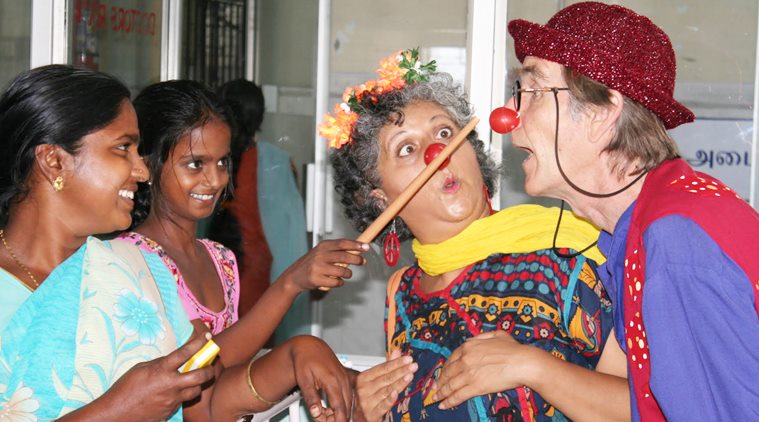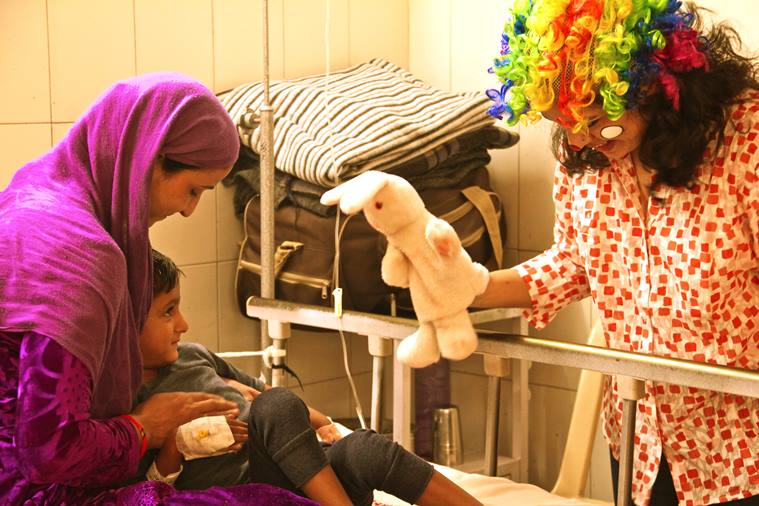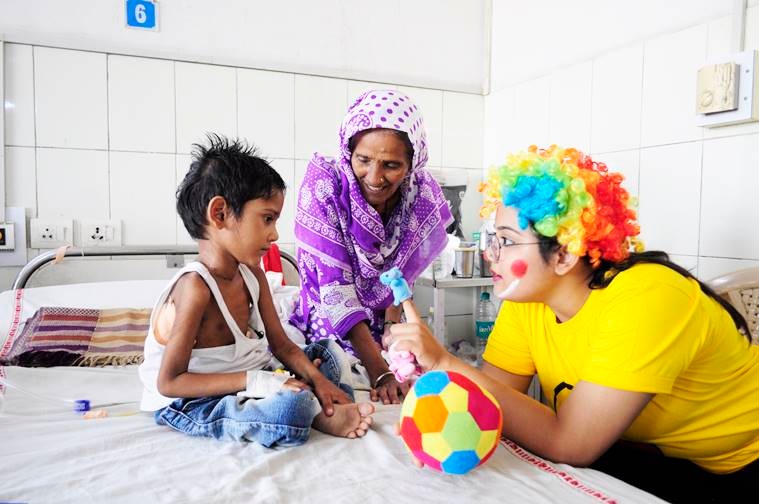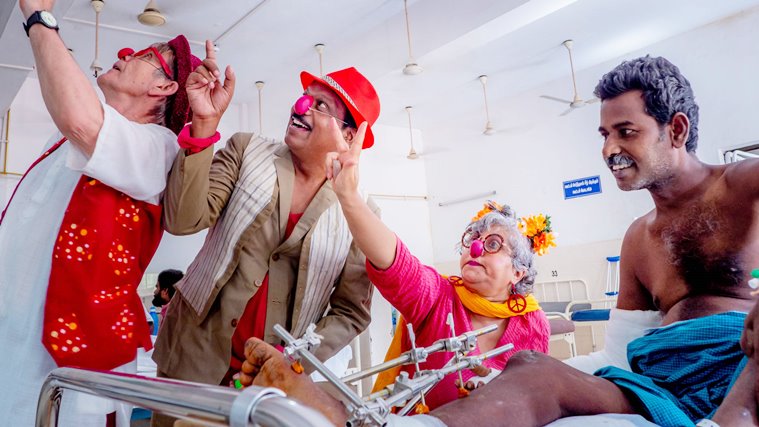
Colourful wigs, bright clothes and the atypical clown nose coupled with a wide, infectious smile are not something usually associated with a hospital. But a group of people dressed up exactly like that are cheering up gloomy hospital wards, helping patients laugh and heal, one joke at a time.
Anu, a patient at Delhi’s Apollo Hospitals, had an excruciating stomach ache. “She had been crying all day,” said the young girl’s mother. All it took to bring back Anu’s lost smile was a look at the clown peeping at her from the door of her ward and the hit song Pyaar Hua Iqraar Hua. “I have been in unbearable pain which is why I cried. I wish you could come every day; I miss you,” Anu tells Sheetal Agarwal.
Similarly, Muskan giggles away forgetting her pain as she plays and goofs around, despite being restricted to her bed, with Agarwal at the Chacha Nehru Baal Chikitsalaya. “Doctors said it was difficult for her to make it. But a little hope helped her go a long way. She got better and walked back home,” said Agarwal, who said they are usually not told about the ailment that the patient is suffering from.
Hospitals “don’t need to be gloomy,” said another clowning artist Ashwath Bhatt, adding that “there can be laughter and gaiety in a hospital too”.
Bhatt and Agarwal are medical clowns who practice clowning therapy or medical clowning in India, engaging with patients through laughter, stories and games to improve their mental, emotional and physical well-being.
“Clown therapy is a kind of distraction therapy that humanises the hospital environment. It helps to break the gravity by swiftly driving the patients’ mind towards happy feelings. It also helps minimise pain levels and promotes psychological wellness,” explains Agarwal, founder of Clownselors.

However, it has not been easy to persuade hospitals on the need for clowns. “This is because they can’t understand why there should be fun and jokes in a hospital,” Bhatt remarks.
Clowning therapy or therapeutic clowning is believed to have begun with Patch Adams, who is best known for his work as a medical doctor and a clown. A social activist who devoted over 40 years of his life to changing America’s healthcare scene, Adams has always highlighted the role of creativity, laughter and joy in the healing process. Actor Robin Williams even played Patch Adams in a movie with the same title.
While it has become a fairly common practice in the West, medical clowning has slowly started gaining momentum in India in the last year. However, the therapy is not limited to children, and as Bhatt points out “it is not a performance; it is a connect and needs to be done methodically”.
According to Fif Fernandes, who runs the MeDiClown Academy with Hamish Boyd, medical clowns are people of all ages, backgrounds and walks of life who humanise the medical profession and stressful environments. They are masters of transforming spaces and moods of patients, families and staff, she informs. “They can work in all areas of the hospital/healthcare (palliative care, oncology, psychiatry, emergency) and homecare,” she says.

Fernandes adds that medical clowning not only helps patients including children by reducing pain and stress but also allows them to express their unpleasant feelings in a healthy way. It also supports medical teams by improving communication with patients, assisting them to perform examinations and procedures, supporting patients and staff in receiving or delivering bad news and “humanises medical staff so the patients are not afraid of doctors,” she adds.
Agarwal says. “Hospitals often don’t give enough importance to mental health. We must realise that physical and mental health go together and medical clowning fills this gap that exists in care centres.

But are there specific themes around which the therapy works? “There is a lot of spontaneity in every interaction and the ‘theme’ usually derives from the present moment. The clown loves the time where the patient takes the lead in an activity — be it magic or storytelling or just sitting quietly together,” explains Dr Sailakshmi Balijepalli, paediatrician and founder Ekam Foundation.
“During individual or group activities, we may take up an empowerment theme, where the patients become superheroes. We also do value-based laughter themes to redirect negative thought patterns,” she adds.
Balijepalli shares that when dealing with seniors, they may engage in memory-based activities, such as songs and dances of their era, or ask them to relate “something wonderful that happened in their life (a marriage or birth of first child) and we can act it out for them”.
“If we are invited in for a specific task, such as physiotherapy, the theme could be blowing out a birthday cake to get a child to breathe deeply. Or we could say we are a feather and the child can blow us around the room. We can get caught up in curtains or actually be blown all the way out of the door. When the child or even the adult laughs at this it means even more oxygen gets into the lungs,” she shares.
As of now, clowning is practised in only a few Indian cities like Delhi, Bengaluru, Ahmedabad, Hyderabad, and Mumbai. “We need proper organisation and trained professionals to make medical clowning a success,” says Bhatt. Agrees Agarwal, who believes that clowning should be introduced as therapy in medical settings across India.
Dr Balijepalli says the trend calls for spreading awareness. “Medical clowning is a serious healing activity but it is still in its infancy in India. It is, therefore, vital to step beyond the inconsistent voluntary model, which although has the right intentions, lacks professional training. Everyone in the country who is practicing clowning in healthcare — be it therapeutic, hospital, clown doctor, compassionate, clownseling, humanitarian, medical — needs to come together and support each other. Let us all adhere to best global practices; we must be regarded as professionals providing an essential service in India.”